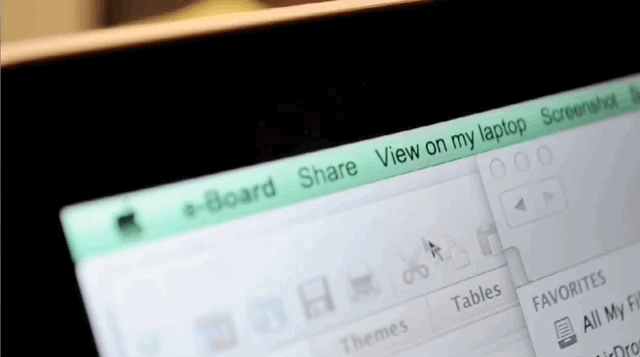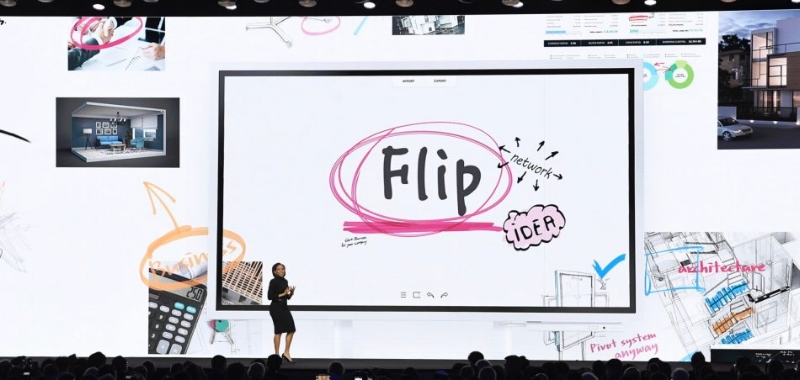design for collaboration
In 2014 our lab was asked to consult with the B2B Displays business, specifically the team dedicated to large “e-board" touch screens, to identify growth areas where new design approaches might create a competitive advantage. Having previously worked in a previous life at Cisco's Collaboration Business unit, I was eager to investigate the space again with a more hardware+software centric view.
Goal
Identify and develop concepts, find opportunity areas to grow the B2B display business.
Role
Design and Strategy lead, script writer, producer
Result
We changed the product strategy from “Digital Whiteboards” to meeting management /collaboration /capture tools, allowing us to target smaller (3 ~ 10 person) conference rooms with smaller, more flexible (i.e. 55" vs 80") high-res displays.
“Flip” whiteboard released @ 2018 CES
PROCESS
Exploratory research
Our first step was to purchase our flagship educational product and see what it did. One day a truck arrived with a brand new “Magic IWB”, an 80in 1080p display on a heavy duty stand, with an IR touch overlay and a Windows PC bolted to the back.
Our e-board (left) and a slightly more awesome promotional image showing its primary use case.
The existing product focused on primary markets of education and board rooms, where 1-2 people present or lecture a large audience. This meant:
Projector replacement - The 80" display was one of the primary selling points of this device.
One user - A single, (hopefully) trained lecturer would “command” the display.
One way exchange - Audience participation was limited to downloading mobile apps and posting questions or answer polls.
School tools - The whiteboard was a set of drawing tools dedicated to teaching, such as flip charts, auto formatting of math equations, and of course Powerpoint.
Educators appreciated the ability to engage and capture their student's attention with new technology.
Once placed in the context of a meeting room, a number of obvious usability issues arose.
But our office was not a classroom; when attempting to use the e-board in a work context, a number of obvious usability issues cropped up:
Low res - An 80” 1080p screen looks great from 10 feet away; from 1 foot away the pixels are excruciatingly large. The poor resolution of both the touch overlay and display made no substitute for the fine-grained pen control of a real white board, and the manufacturing cost savings were certainly not worth it.
Memory hole - The flip chart style of drawing management created a nightmare of unlabeled images to navigate through. With no context about what was being discussed, drawings were dumped into a single folder on a network share drive with no naming convention that anyone (or more accurately no one) could access.
Too big – The 80" screen had to be angled to fit through doors and practically needed the room to be built around it, precluding purchase for the majority of small office conference rooms, which according to market research was the largest addressable market.
Our user researcher ran a 605 person nation wide survey to identify pain points associated with meetings themselves:
Little need for whiteboards - Only 16% of attendees felt whiteboards were useful. Most jobs involved reviewing/presenting/modifying files from a computer, with little need to illustrate or brainstorm new ideas. The sole purpose of displays was to broadcast attendees laptop screens for group viewing.
We already take good notes – When we do need to write things, we are typically surrounded by real whiteboards, phones to take pictures of whiteboards, paper, and laptops, all of which are faster/better than a digital whiteboard. 44% of users reported carrying paper notebooks with them to meetings.
NOT a 10ft UI - Viewers in a conference room sit much closer to the display than they do at home; 4K is especially noticeable at shorter distances.
DESIGN, BUILD, TEST
Based on our initial findings, I found a special TV stand designed for flexibility, mounted a smaller 50" 4K TV, and added a PQ Labs touch overlay. We designed several UI elements to help us articulate a concept around improving the ergonomics of meetings themselves. Core features of our strategy included:
Fits where you need it - Our smaller display and flexible stand design allowed the user to raise/lower/rotate the screen to fit different room sizes/ergonomic profiles, and wheel the display anywhere in an office for use.
Presentation <-> feedback loop - A simple screen capture function made presenting and annotating documents the core use case of the display, more frequent than brainstorming and whiteboarding.
Connect/Control - Beyond HDMI, our display could control connected PCs using the touch screen as an input device, allowing the use of tools like Prezi, Keynote, or Google Docs without having to install or log in on the host PC.
Meeting Memory – Assets captured during the meeting were posted to a space called The Wall, a searchable repository where files, drawings and screen captures from project meetings were organized by meeting name.
Deliverables included a product demo video (shot using my own SLR and some gracious teammates) and a slide deck combining our research and design concepts into a product design strategy. We presented our work to a very receptive product team, who were intrigued by the smaller form factor and new use cases around quick capture of feedback and notes during the meeting.
Using our prototype, our research team ran focus groups and in-person studies of people in offices to find out what people needed from meeting room equipment. The resulting footage of people reacting to the prototype was powerful validation of the concept.
Our prototype was used to elicit feedback from real employees at various offices in the bay area.
Result
I chose to make videos of everything to increase the longevity of the strategy; a video could be easily shared and re-played more often that I could fly to Korea to present. This strategy proved very successful; in 2016 a member of the new office display design team reached out to pick my brain over our video and strategy deck, and informed me that they were still required viewing for the team, foundational to the design strategy they were now pursuing.
At CES 2018 Samsung introduced Flip, with an adjustable stand, 55” display, quick annotation capability, connected device control, and meeting management features front and center. I was surprised and excited to see so many of the concepts make their way to the stage after such a long time.
The Flip electronic whiteboard was a surprise addition to Samsung's 2018 Keynote.










